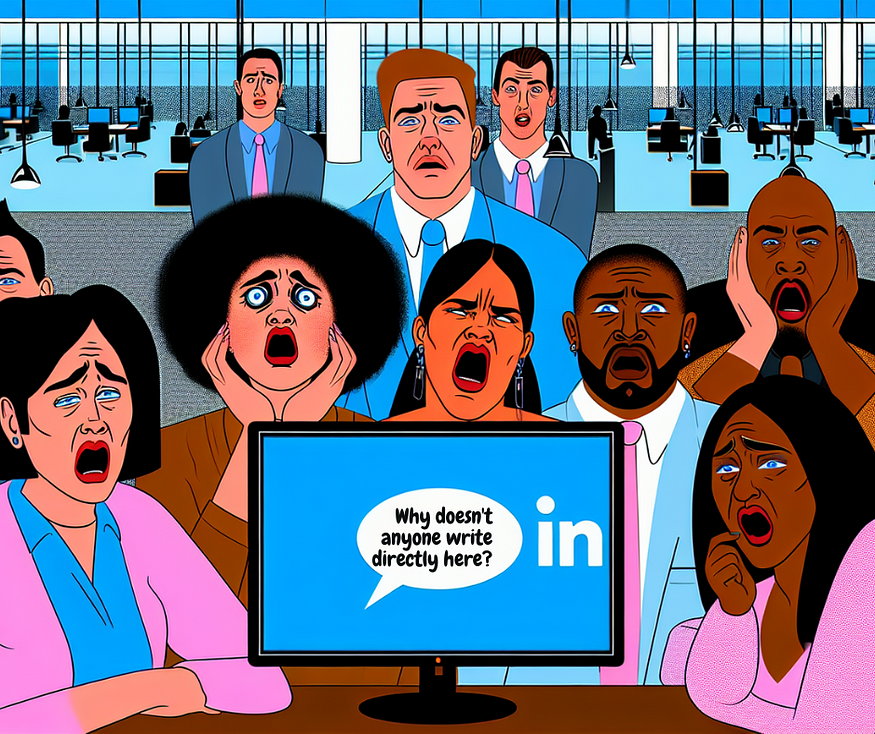
Why No One Writes Directly to LinkedIn Despite Its Potential
LinkedIn is the go-to platform for professionals worldwide, but when it comes to original content creation, it seems to be an afterthought. Why are writers giving LinkedIn the cold shoulder? Let’s dive into this curious phenomenon.

Writing on LinkedIn feels like shouting into the corporate void.” — Probably your inner writer
The Untapped Potential of LinkedIn as a Publishing Platform
LinkedIn boasts over 800 million users, many of whom are professionals seeking high-quality content. So why isn’t LinkedIn bursting at the seams with original articles?
It’s because creating compelling, well-researched content takes time and effort. Professionals often find themselves juggling numerous responsibilities, leaving little room for writing. Additionally, the instant gratification of quick posts or comments can seem more appealing. However, those who do invest in producing original articles can significantly enhance their visibility and establish themselves as thought leaders in their field.
Benefits for Workers
When professionals take the time to read and engage with well-crafted articles on LinkedIn, they unlock a range of significant benefits:
1. Increased Productivity: Articles focusing on productivity tips and best practices can provide workers with actionable strategies to optimize their workflow, manage time better, and reduce stress, leading to an overall increase in productivity.
2. Enhanced Cooperation: Reading about cooperative strategies and team-building techniques can foster a stronger sense of unity and collaboration within teams. This can result in improved morale and more effective collective problem-solving.
3. Better Industry Understanding: Staying updated with industry trends and news through in-depth articles helps workers remain competitive and informed. This knowledge can aid in making strategic decisions and staying ahead in the ever-evolving market landscape.
4. Ongoing Training and Development: Access to articles that cover continuous learning and development opportunities can empower workers with new skills and knowledge. This continual enhancement of their capabilities can lead to career growth and personal satisfaction.
By leveraging LinkedIn as a robust publishing platform, professionals can create a well of knowledge that not only boosts their own careers but also contributes to the growth and development of their peers. This ripple effect of shared knowledge and insight is invaluable in today’s interconnected professional environment.

Increased User Engagement
Monetizing content could revolutionize user interaction on LinkedIn. Imagine getting paid for your wisdom! Not only would this incentivize existing users to engage more frequently, but it would also encourage higher-quality posts and discussions. As users spend more time on the platform, LinkedIn would see an increase in metrics such as daily active users and session duration, making it more attractive to advertisers and investors.
Attraction of New Talent
Creatives would flock to the platform, enriching the ecosystem with diverse perspectives. By offering monetization opportunities, LinkedIn could attract a new wave of talented writers, thought leaders, and influencers. This influx of content creators would not only diversify the range of content but also draw in their followers, expanding LinkedIn’s user base and enhancing its global reach.
Enhanced Content Quality
Let’s face it, the promise of cash can turn casual contributors into meticulous writers. Introducing financial incentives would likely result in more thoughtful, well-researched, and high-quality posts. This increase in content quality would improve user satisfaction and trust in the platform, making LinkedIn a go-to source for industry insights and professional knowledge.
Revenue Growth for LinkedIn
Monetized posts could open up new streams of revenue for LinkedIn through ad placements, sponsored content, and subscription models. Writers generating high engagement could be prime candidates for targeted ads, creating a symbiotic relationship where both LinkedIn and the content creators benefit financially. Additionally, LinkedIn could implement a premium subscription model for exclusive content, driving a consistent income flow.
Stronger Community and Network Effects
Monetization could foster a more vibrant and interconnected community. Writers who are financially rewarded for their contributions are likely to invest more in building their networks and engaging with their audience. This would fuel the network effects, making LinkedIn an even more powerful platform for professional growth and collaboration.
Competitive Edge in the Market
By adopting a monetization strategy, LinkedIn would set itself apart from other professional networking sites and platforms. This competitive edge could attract not just individuals but also businesses looking to collaborate with top-notch writers and industry experts. Ultimately, this would solidify LinkedIn’s position as the leading professional networking site globally.
Monetizing writers offers a plethora of benefits that extend beyond individual gains. For LinkedIn, this could mean increased engagement, a surge in talented users, improved content quality, additional revenue streams, stronger community bonds, and a significant competitive advantage in the market.

Fear of Losing Professional Touch
1. Content Quality Guidelines:
– Implement strict editorial standards to ensure that all monetized content upholds LinkedIn’s professional focus. Writers should adhere to guidelines that emphasize quality, relevance, and professionalism.
2. Curation and Moderation:
– Use a combination of AI and human moderators to evaluate and curate content. This ensures that posts align with LinkedIn’s values and prevent the spread of clickbait.
3. Niche Segmentation:
– Create specialized content categories or channels, allowing professionals to filter and follow topics relevant to their industry or interests. This helps maintain a high level of content relevance and avoids diluting the professional atmosphere.
4. User Feedback Mechanism:
– Introduce a robust feedback and rating system, allowing users to rate and comment on content. This can help highlight high-quality posts and demote those that fall short of professional standards.
Potential for Content Overload
1. Personalized Content Feeds:
– Leverage advanced algorithms to tailor content feeds based on user behavior, preferences, and professional interests. This can help users see the most relevant posts and avoid feeling overwhelmed.
2. Content Quotas:
– Set limits on the number of monetized posts that can appear in a user’s feed within a given timeframe. This ensures a balanced mix of organic and monetized content.
3. Exclusive Content Zones:
– Create dedicated spaces or tabs for monetized content, similar to how LinkedIn groups are separated. Users can choose to engage with this content at their discretion.
4. Quality Over Quantity:
– Incentivize writers based on engagement metrics rather than volume. This means rewarding high-quality posts that drive meaningful interactions rather than sheer quantity.
By carefully implementing these strategies, LinkedIn can monetize writers while maintaining its professional ethos and preventing content overload.
Here’s one for you: Why don’t skeletons fight each other? They don’t have the guts. Now, would LinkedIn have the guts to change?

Case Studies of Successful Content Monetization on Other Platforms
Medium’s Model
Medium incentivizes writers by paying them based on engagement metrics such as reading time, claps, and the number of subscribers who read their content. This model has proven effective in promoting high-quality articles and fostering a dedicated reader community.
Factual Data from 2023:
1. Earnings Statistics:
– In 2023, Medium reported that the top 1% of writers earned over $50,000 annually.
– The platform paid out more than $25 million to writers, with some top articles earning thousands of dollars each.
2. Engagement Metrics:
– Articles with higher reading times and engagement (measured in claps and comments) saw exponentially higher earnings.
– Medium’s Partner Program saw an increase in average earnings per writer by 20% compared to the previous year, emphasizing the effectiveness of their engagement-based monetization strategy.
3. Success Stories:
– Popular writer Todd Brison shared that his monthly average income from Medium in 2023 was around $6,000, driven by consistent high engagement on his articles about personal development and career advice.
– Another success story is Zulie Rane, who reported earnings of over $100,000 throughout the year by focusing on writing about social media strategies and content creation tips.
YouTube’s Monetization
YouTube employs a variety of monetization methods including ads, Super Chats, channel memberships, and merchandise shelf. This multi-faceted approach allows creators to diversify their revenue streams and maximize earnings.
Factual Data from 2023:
1. Ad Revenue:
– YouTube’s ad revenue hit a record high in 2023, with over $30 billion generated from ad sales. Creators receive a substantial share of this, with top-tier YouTubers earning millions.
– For instance, MrBeast (Jimmy Donaldson) reportedly earned over $50 million in 2023 from ad revenue alone, not including other monetization methods.
2. Memberships and Super Chats:
– Over 10 million viewers subscribed to YouTube channel memberships in 2023, contributing significantly to creators’ incomes.
– Popular gaming YouTuber, Valkyrae, noted that her monthly income from memberships and Super Chats was around $40,000, illustrating the high earning potential from these interactive monetization options.
3. Diverse Revenue Streams:
– Merchandise sales via the YouTube Merchandise Shelf exceeded $200 million in 2023, demonstrating the effectiveness of YouTube’s integration for creators to sell products.
– Channels like Dude Perfect expanded their revenue streams by launching exclusive merchandise, which contributed significantly to their overall earnings.
4. Success Stories:
– Marques Brownlee (MKBHD), a tech reviewer, reportedly made over $12 million in 2023 from YouTube alone, combining ad revenue, sponsorships, memberships, and merchandise sales.
– Emma Chamberlain, a lifestyle vlogger, significantly boosted her earnings by diversifying her income with ads, exclusive content for members, and her own merchandise line.
Both Medium and YouTube have demonstrated successful content monetization strategies by focusing on engagement and providing multiple revenue streams. The data from 2023 highlights the significant earnings potential and provides concrete examples of how creators on these platforms have leveraged these models to achieve substantial financial success.

Emphasize Quality Over Quantity
One of the most critical lessons LinkedIn can glean from successful platforms like Medium and YouTube is the importance of prioritizing content quality over sheer volume. These platforms use sophisticated algorithms that reward meaningful engagement, such as time spent on content, comments, and shares, rather than mere clicks or superficial interactions.
Case Study: Medium’s Claps and Reading Time
Medium’s mechanism of using ‘claps’ to gauge reader approval and time spent reading an article encourages authors to produce high-quality, engaging content. This model shifts the focus from generating clicks to creating content that resonates deeply with readers.
Implementation for LinkedIn:
– Introduce metrics that prioritize reader engagement and satisfaction, perhaps through a similar ‘clap’ function or detailed analytics showing average read time and interaction levels.
– Reward authors whose content is not only clicked on but is also read thoroughly and sparks meaningful conversations.
Create a Sustainable Revenue Model
Ensuring that content creation on LinkedIn is financially rewarding is key to attracting and retaining high-caliber writers and industry experts. This can be achieved through multiple revenue streams, much like successful platforms have done.
Case Study: YouTube’s Ad Revenue Sharing
YouTube’s Partner Program, which includes ad revenue sharing, has been instrumental in supporting a vast ecosystem of content creators. This model allows creators to benefit directly from the traffic they generate.
Implementation for LinkedIn:
– Explore partnership programs that allow authors to monetize their content through ad revenue shares or premium subscriptions.
– Introduce membership tiers for users, offering access to exclusive content or features for a subscription fee, much like Medium’s membership program.
Supporting Data:
– According to a study by Wyzowl, 87% of video marketers on YouTube reported positive ROI from their video marketing efforts.
– Medium reported that their membership program, launched in 2017, saw significant user uptake, contributing to sustainable revenue for content creators.

Considering its unique, professional audience, LinkedIn has the potential to become the definitive platform for industry-specific content, positioning itself as a place where thought leaders and professionals share insights and engage in intellectual discourse.
Case Study: Substack’s Writer-First Approach
Substack has transformed how writers monetize by allowing them to sell subscriptions directly to their audience. This model empowers writers by offering financial control and a direct relationship with their readers.
Implementation for LinkedIn:
– Create opportunities for writers to build their brand and monetize through direct audience subscriptions, allowing them to provide premium content to their followers.
– Develop a robust system for showcasing top industry content, helping professionals stay updated on the latest trends and insights from experts in their fields.
Potential Impact:
– With over 800 million users, LinkedIn’s adoption of these strategies could revolutionize professional content creation, making it the primary platform for industry thought leadership.
– By compensating top contributors, LinkedIn not only motivates high-quality content creation but also attracts more industry experts who can provide valuable insights to the community.
By learning from these successful models, LinkedIn can refine its platform to better serve its users, encourage deeper engagement, and create a vibrant ecosystem where professional content thrives.

Final Thought
LinkedIn has a unique opportunity to transform its platform into a vibrant marketplace of ideas by facilitating the creation and monetization of high-quality content. Many professionals are eager to contribute substantial, thought-provoking material that could enrich the community. By enabling this content to be monetized, LinkedIn would encourage a wealth of diverse perspectives and expertise to flourish.
The professional industry is at a crucial juncture where expanding the boundaries of conventional thinking is imperative. Reliance on internal knowledge alone limits innovation and stifles growth. By embracing and promoting diverse and external insights, LinkedIn can empower its users to think outside the box, fostering an environment of creativity and solidarity.
Cutting off access to these external streams of knowledge would not only impede individual advancement but also hinder collective progress. Therefore, it is vital for LinkedIn to evolve and support content creators in delivering valuable, profitable information. This initiative would not just benefit the creators, but it would also serve as a catalyst for the entire professional ecosystem to thrive.
Now is the time for LinkedIn to step up its content game and lead the charge toward a future where professional growth and innovative thinking are nurtured and rewarded.
FAQs
1. Why isn’t LinkedIn already monetizing writers? LinkedIn might be cautious about maintaining its professional image and avoiding content overload.
2. How can LinkedIn balance content quality and monetization? By implementing engagement-based rewards and ensuring a stringent quality control process.
3. What are the risks of not monetizing writers on LinkedIn? Missed opportunities in user engagement and attraction of new talent.
4. How successful are other platforms in content monetization? Platforms like Medium and YouTube have seen significant success by focusing on engagement metrics and diverse revenue models.
5. What could be the future of writing on LinkedIn? With proper strategies, LinkedIn could transform into a primary platform for professional content, rewarding both the creators and the readers.
Grab your pens (or keyboards) LinkedIn writers — it might just be worth it soon!





Leave a comment